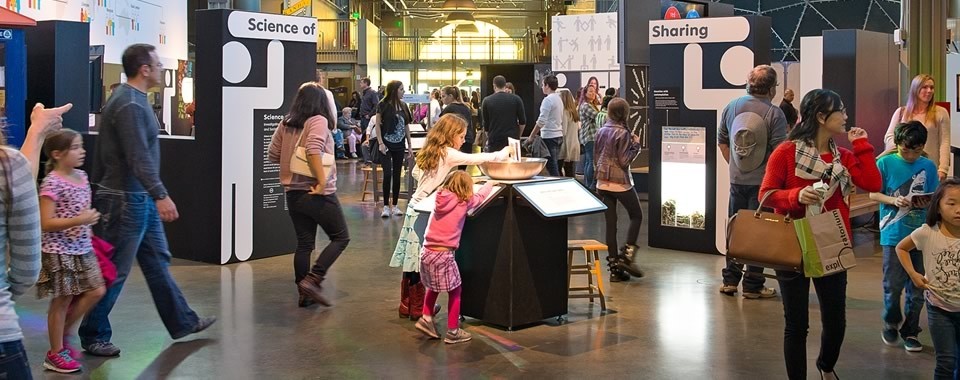
This blog post is a review of the exhibit The Science of Sharing, Investigating Competition, Cooperation, and Social Interaction which is currently on display at The Exploratorium in San Francisco.
Bravo to the Exploratorium for creating this exhibit! The Exploratorium has always been the place to go in The City for super fun and interactive exhibits relating to science and perception. The Tactile Dome, for instance, is a pitch-black geodesic dome filled with weird things to touch as you grope through it in the dark. 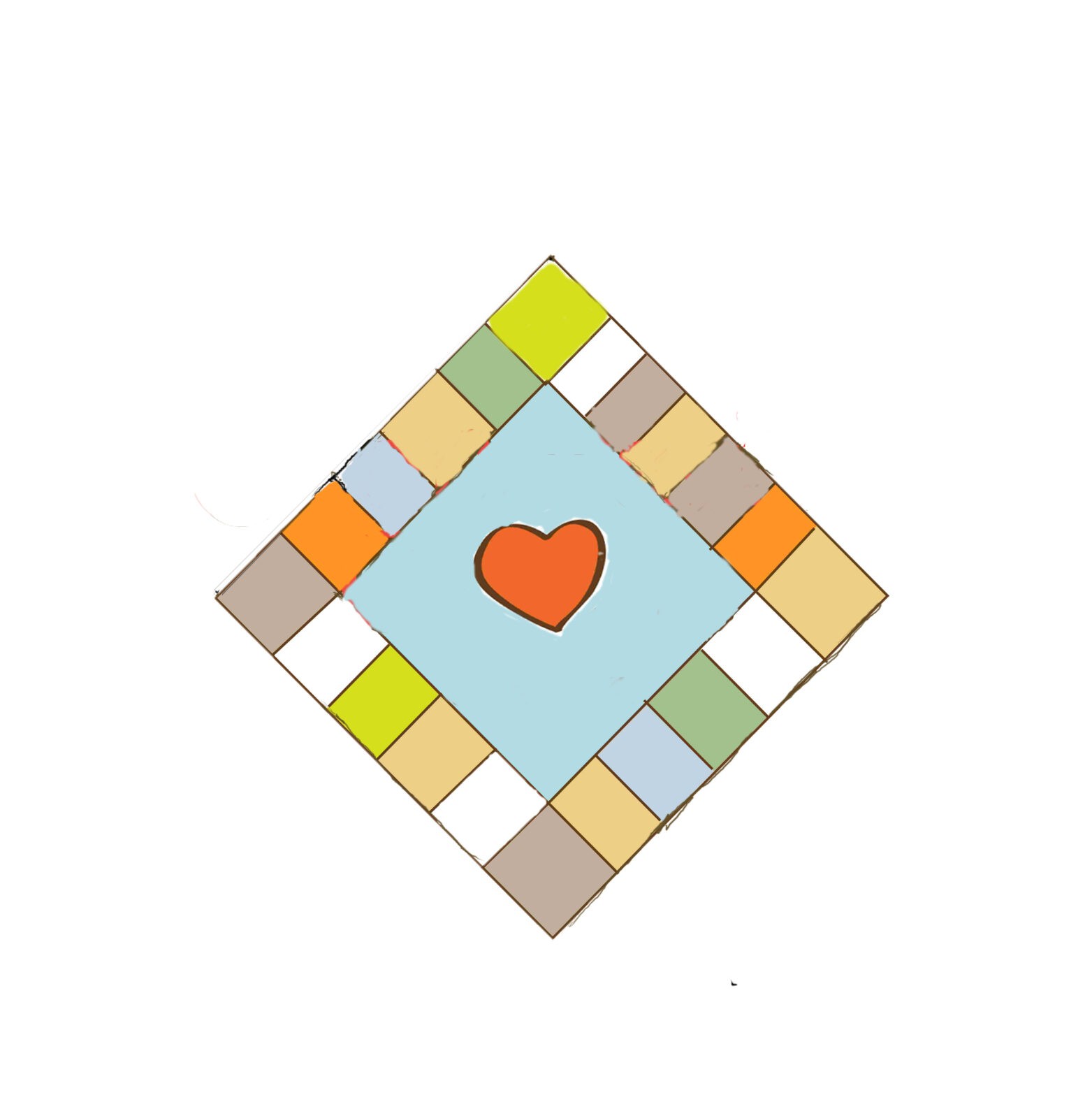 The Science of Sharing invites the visitor explore social space rather than physical space. The question at the heart of the exhibit as well as  at the heart of CooperativeGames.com—is whether ‘tis nobler to Cooperate or Compete. Exploration in The Science of Sharing is through hands-on activities, thoughtful displays, clever conundrums, and yes-games! It’s rare in our hyper competitive society for any public institution to facilitate reflection on the assumed merits of competition. Competition is a sacred cow (or maybe gaudy wallpaper?) that is pervasive yet almost never critically examined. Kudos to the Exploratorium for breaking the ice.
The Science of Sharing invites the visitor explore social space rather than physical space. The question at the heart of the exhibit as well as  at the heart of CooperativeGames.com—is whether ‘tis nobler to Cooperate or Compete. Exploration in The Science of Sharing is through hands-on activities, thoughtful displays, clever conundrums, and yes-games! It’s rare in our hyper competitive society for any public institution to facilitate reflection on the assumed merits of competition. Competition is a sacred cow (or maybe gaudy wallpaper?) that is pervasive yet almost never critically examined. Kudos to the Exploratorium for breaking the ice.
I enjoyed the installation Collaborative Shapes. It consists of a rope posted to a backdrop. Visitors are asked to pair up and try to make a shape with the rope—a square, crescent, etc.) with their eyes closed. 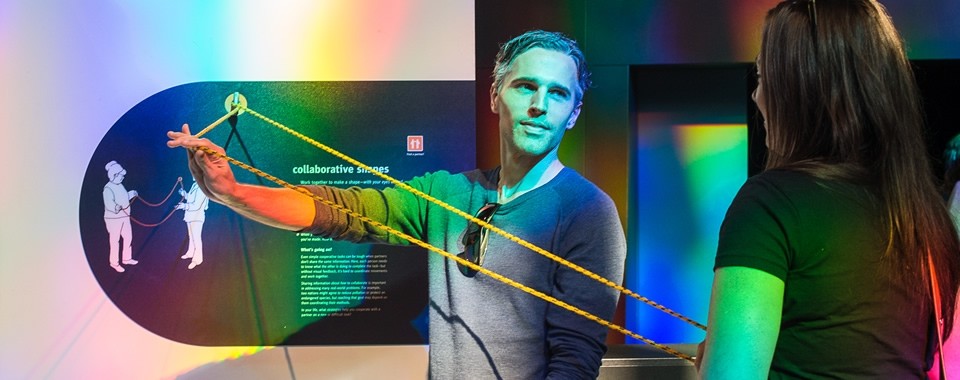 Partners can talk and communicate any way they wish EXCEPT that eyes need to stay shut. I tried this and watched others do it too. The shapes turned out pathetic! The moral of the story: Cooperative tasks are difficult when partners don’t share complete information. For cooperation to work, everyone needs to have access to essential information relevant to the situation at hand.
Partners can talk and communicate any way they wish EXCEPT that eyes need to stay shut. I tried this and watched others do it too. The shapes turned out pathetic! The moral of the story: Cooperative tasks are difficult when partners don’t share complete information. For cooperation to work, everyone needs to have access to essential information relevant to the situation at hand.
 Team Snake is also really cool. It’s a cooperative digital game and seemed to be one of the most popular exhibits. The game goal is to work together to keep a fast-moving snake alive and growing. Coordination is required to feed him apples he needs to live and grow and avoid hitting the walls of his container. 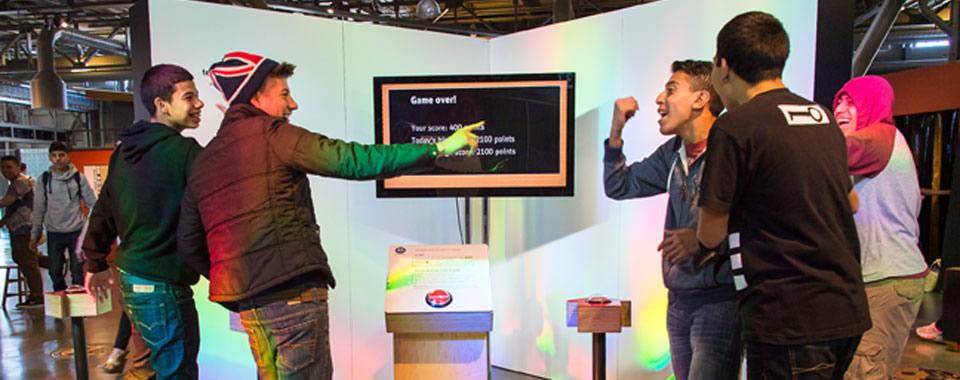 This is an active game that requires group strategy and fosters camaraderie. For lots of visitors kids to adults, the game was big fun!
This is an active game that requires group strategy and fosters camaraderie. For lots of visitors kids to adults, the game was big fun!
 In a different vein, Red/Blue is a competitive game in the exhibit. Like Team Snake, the game is a very inviting digital game that prompted a lot of visitor participation the day I was there. 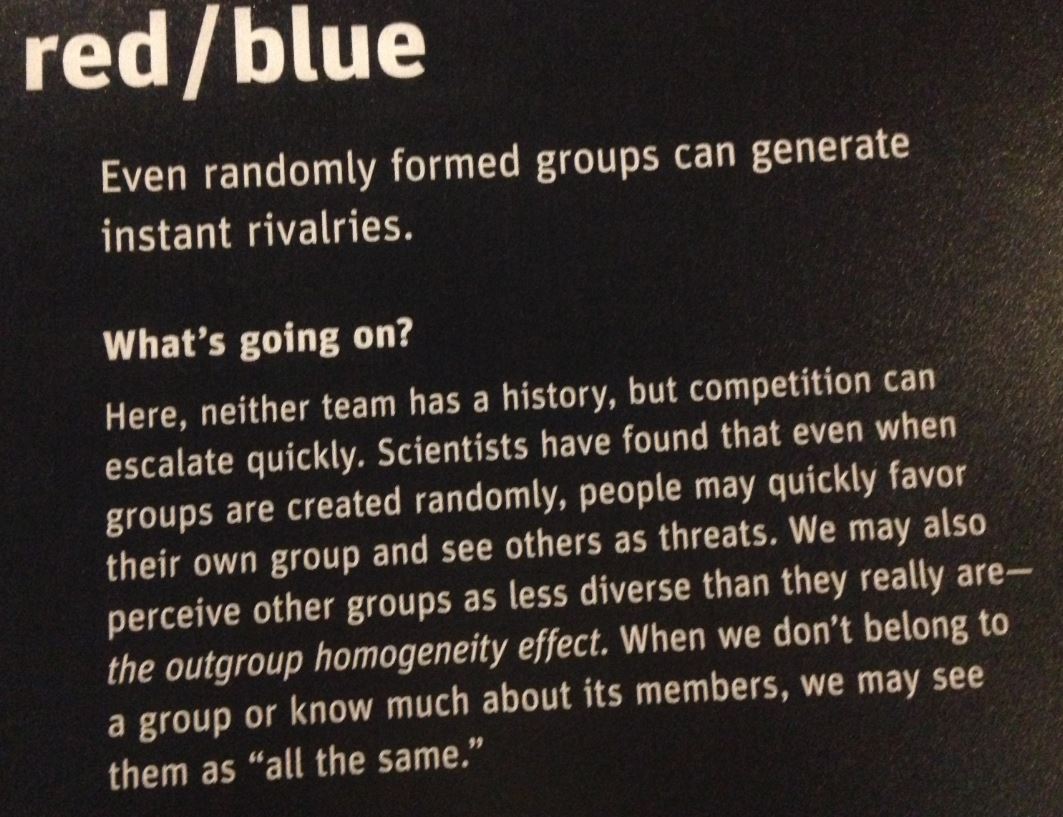 Though Red/Blue was popular and fun according to the visitors I asked about it, its vibe was completely different than Team Snake. Instead of relaxed smiles and collegial attitudes, players displayed a fiendish twinkle in their eyes. In Red/Blue, it’s time to go all out to beat your opponent and prove yourself. When the game was over, I noticed a certain awkwardness and lingering aggressiveness as friends were—even if briefly—turned into rivals. It takes a little while to get over competitive encounters like this where one player is encouraged to thoroughly trounce another. One wonders about the long term psychological and social effects of a steady diet of competitive games such as this. A sign posted near Red/Blue explains the social risks of competition…
Though Red/Blue was popular and fun according to the visitors I asked about it, its vibe was completely different than Team Snake. Instead of relaxed smiles and collegial attitudes, players displayed a fiendish twinkle in their eyes. In Red/Blue, it’s time to go all out to beat your opponent and prove yourself. When the game was over, I noticed a certain awkwardness and lingering aggressiveness as friends were—even if briefly—turned into rivals. It takes a little while to get over competitive encounters like this where one player is encouraged to thoroughly trounce another. One wonders about the long term psychological and social effects of a steady diet of competitive games such as this. A sign posted near Red/Blue explains the social risks of competition…
The Science of Sharing exhibit featured several riddles for contemplation. Consider the Public Goods Dilemma, shown below.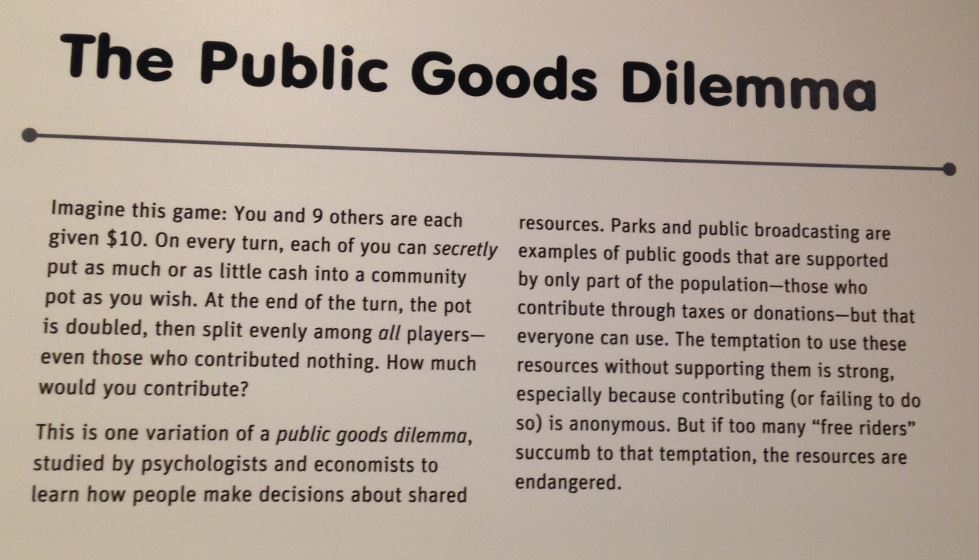
On my way out of The Science Of Sharing exhibit, I walked by the Give and Take Table. It consists of a great big silver bowl reflecting the people staring into it—revealing their thoughts as well as their faces. Instructions ask visitors to add or remove whatever they wish to the bowl. I sat and watched what happened there for a while.
I wish I could report the bowl was made overflowing with an abundance of meaningful and treasured items that visitors contributed to the commons…maybe drawings, poems, trinkets, money? Or for real trust—how about something edible? I guess we are a ways from that ideal though, at least at the time that I was observing. People, I hate to tell you, but what I saw in the Sharing Bowl consisted of a few pennies, two dry beans (they looked like pinto beans), a few pieces of wrinkled paper, a couple small beads, an eraser, and one plastic Radio Shack gift card (the big question: Was it depleted or did it have significant value ?)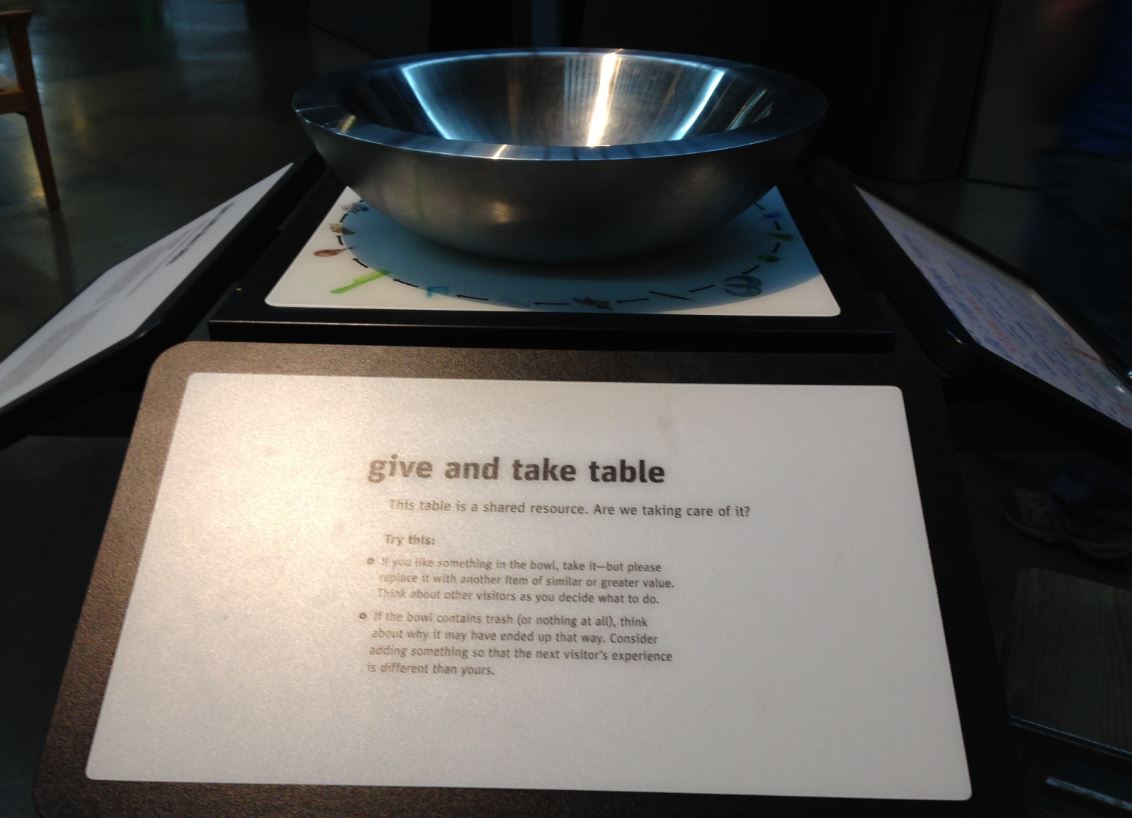
I saw four young men, probably in their 20’s, come up to the bowl. Two of the fellows debated giving/taking but they were hesitant–cautious. Deciding whether to make any kind of donation or trade launched them into extensive analysis of the pro’s and con’s but all comments seemed to be coming strictly from the head with no heart factored in. Worse, one of the fellows said jokingly but seriously that he felt the “smartest†thing to do would be to take everything out of the bowl for himself and not put anything in. He’s no fool; why not take everything you can whenever you can in your own “rational” self interest? The fourth fellow didn’t say much but squirmed uncomfortably. If he objected to this demonstration of The Tragedy of the Commons, perhaps he did not have the words to articulate his concerns. Apparently, I caught the Give and Take Table at an off moment! Personally, I don’t think we are strictly rational beings in the sense that we always act in our material self-interest. Instead, we have prosocial drives and feelings that are inherent and can be cultivated or discouraged.  (Note there COULD have been an altruist to the table. Maybe the Radio Shack gift card was actually loaded! An unresolved mystery…)
Anyway, I have an experiment idea for the folks at the Exploratorium: Let’s put the Give and Take Table next to Team Snake and see what ends up in the Sharing Bowl. Then let’s move it next to Red/Blue and see what happens. If results are similar to the other research comparing cooperative with competitive games, we’d expect Team Snake to inspire a great increase of bounty in the bowl. On the other hand, a bowl placed next to Red/Blue would likely not even elicit two pinto beans.
For more information about The Science of Sharing including where, when, and how to see it visit the Exploratorium website at http://www.exploratorium.edu/visit/west-gallery/science-of-sharing To learn more about cooperative games, to purchase them, or get free cooperative games, visit CooperativeGames.com at https://cooperativegames.com/